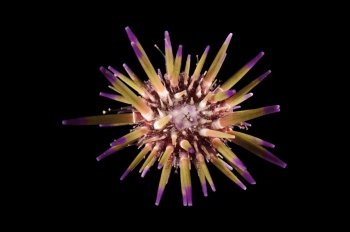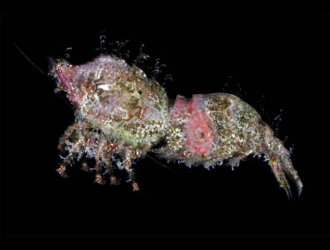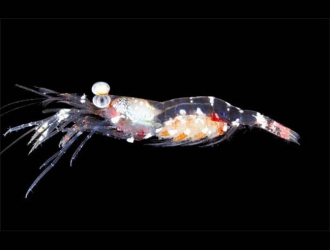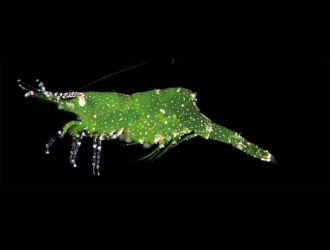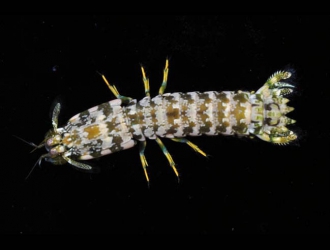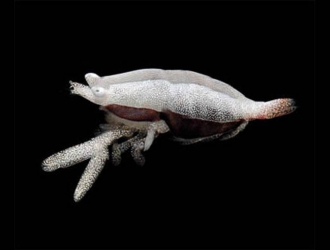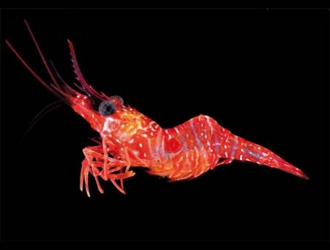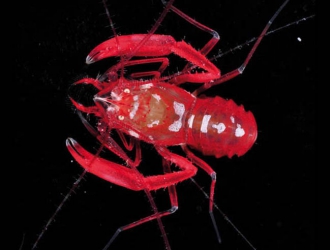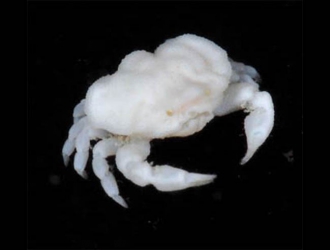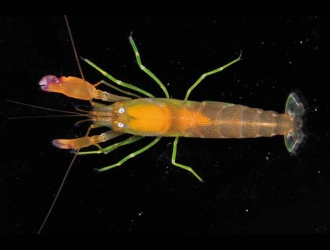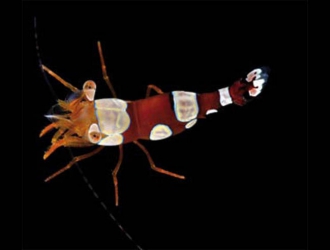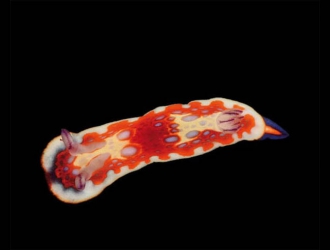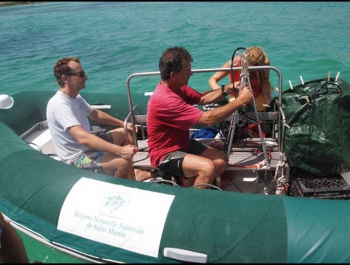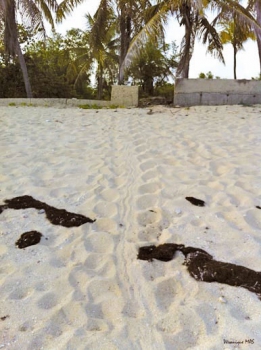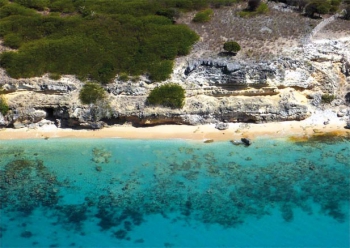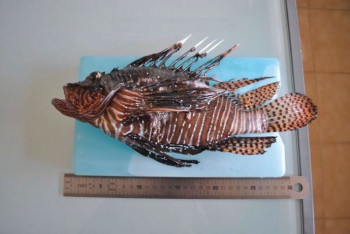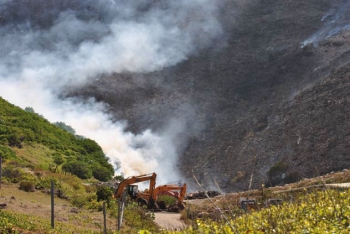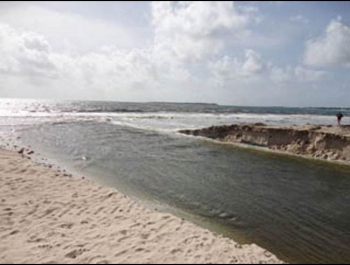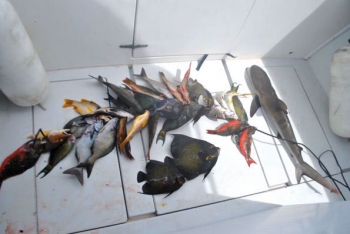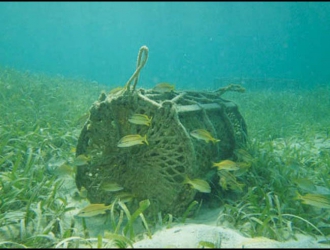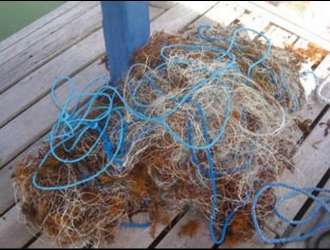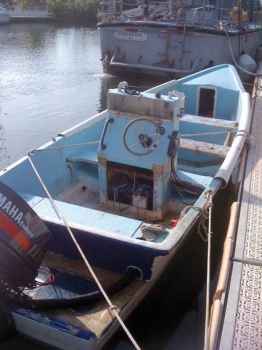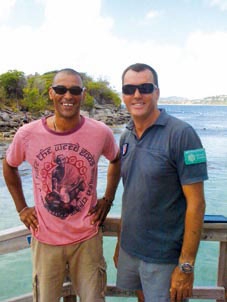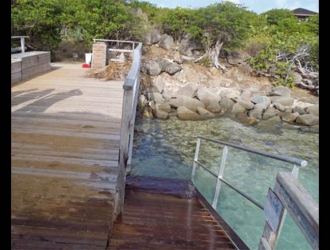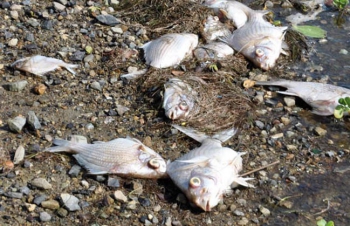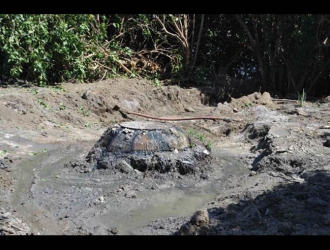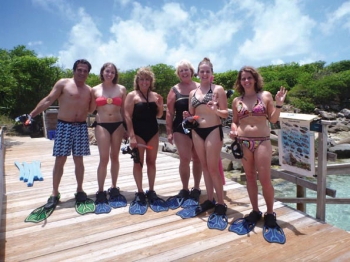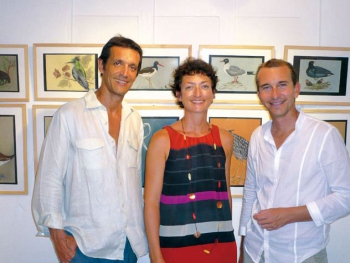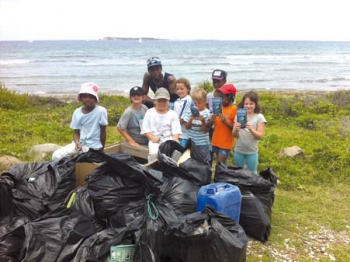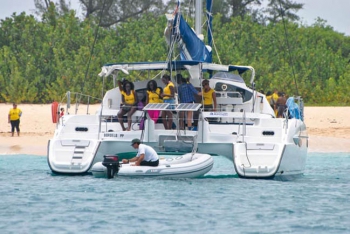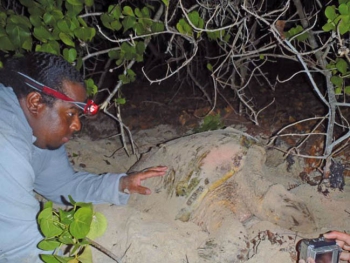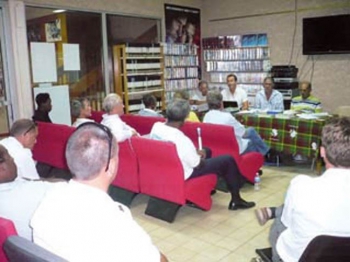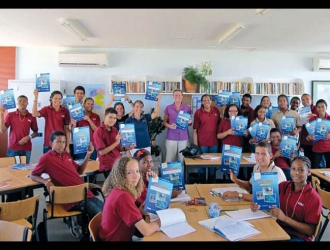Seven scientists, close to 200 dives at night and during the day, a transient laboratory, and three weeks of intense study to identify 700 new species within the Réserve Naturelle!
The first results of this scientific expedition exceeded all of our expectations, and the staff was thrilled to discover so many species never before identified in our waters.
We are pleased to be able to share a little of this information with you in this edition of the Journal, while waiting for a complete report to be published in September, and a photographic exhibit of this little-known fauna.
This natural richness is but another excellent reason to protect our ecosystems, which are increasingly endangered.
But only a global consciousness movement would prevent pollution, stop clandestine fishing, or result in more sea turtles laying their eggs on our beaches. One of the missions of the Réserve is to encourage this kind of thinking, as illustrated in the pages of this Journal. Please enjoy!
Newsletter-15
Newsletter-15
Better Knowledge About Protected Areas And Protected Species
At the time when the Réserve Naturelle de Saint-Martin was created, a total of 480 different species of flora and fauna were estimated to exist in the various zones on land and at sea.
But that was before a recent scientific mission listed more than 700 marine species.
This inventory of fauna, which is part of the Réserve’s management program, took place from April 9-28, 2012.
It was commissioned by the Réserve, financed by the DEAL, and orchestrated by The Marine Environment Observatory of Martinique, with the support of seven university professors, comprising four from the University of Florida and the other three from Brazil, Martinique, and the American Virgin Islands.
The three classifications included in this study are crustaceans (shrimp, crabs...), mollusks (slugs, shellfish...), and echinoderms (sea urchins, starfish, ophiuroids...).
As part of this project, the scientific researchers did dives to take samples of the underwater milieu—sand, mud, rock, grasses, coral reefs—during the day as well as at night, in order not to miss nocturnal species.
They sometimes used an underwater vacuum or a brush to capture the smallest species (less than 1 centimeter). The first samples were inspected at a portable laboratory set up in their rental villa, including scrutiny under a microscope.
Certain samples are still under observation, others surprisingly colorful and graceful, but the final results won’t be available until September 2012.
And maybe we will discover a species unknown until now… the objective is to create a catalogue combining photos of all the species that were observed, both male and female.
And yet, in addition to this important work, there are many samples and animals to observe, on other sites, at other moments, at other depths, without even mentioning the parasites that depend on their hosts.
This study confirms the importance of the natural marine resources in the Réserve.
Underwater sea grass beds, these ordinary marine zones of no particular interest to amateur divers, provide a nursery for numerous species, and offer them protection and food. From mangroves to coral reefs, they represent a fragile, endangered ecosystem that plays a determining role in the purification of coastal waters. The state of their health is as important as that of coral for a project referred to as IFRECOR (French Initiative For Coral Reefs), which has established an observatory for overseas sea grass beds. Their goal is to report on the condition of marine plants and combine all possible information in order to coordinate future activities and propose a robust, user-friendly methodology to follow the development of the sea grass in these zones, that have not yet been studied. With this in mind, Christian Hily, a researcher at the European Institute for Marine Studies in Brest, was sent to Saint Martin by IFRECOR from May 29-June 1, 2012. This scientist had visited the island in 2011 to do a report on the sea grass beds, based on scientific studies done by the Réserve since 2007. This time, his task was to test a new methodology using an underwater camera pulled by a boat. This system allows for the observation a larger perimeter around the sea grass beds to note their state of health, the species present in each area, their density, and the fauna that live there, as well as the quality of the sea grass between the shore and the reef. These observations will be compared to those done by the Réserve and increase the preciseness of available information.
Four species of marine plants in SXM
These sea grass beds consist of flowering marine sea grasses (phanerogams),of which four species coexistent in Saint Martin.
The two principal ones are Thalassia and Syringodium, while the other two are less prevalent.
One of these, Halophila Stipulacea, originally from the Indian Ocean, is invasive.
Its presence was suspected for the past two or three years and has now been confirmed, as the sea grasses are rapidly spreading.
The first nest of green sea turtle this year was noted on May 12 at Plum Bay.
The second was a hawksbill sea turtle nest recorded on May 29 on Tintamare.
By late June, the Réserve had counted nine nests on Tintamare, five at Plum Bay, one on Pinel, and one on the beach at Grandes Cayes.
A total of 57 eco-volunteers - that the Réserve thanks for their work (often thankless as the turtles are not always there, but always useful from a scientific point of view) - got up early in the morning to check out the eight beaches listed as egg-laying sites in order to look for turtle tracks.
The Réserve is also responsible for a ninth site, that of Tintamare.
This number of nests is rather low and indicates the amount of work that remains to be done (dealing with too much light on the beaches, parking of cars, too much noise, keeping the sites clean) in order to make sure that these sea turtles continue to lay their eggs in St Martin in the future.
In Guadeloupe, for example, there can be as many as five or six egg-laying sites every day on the beaches where the turtles are most frequently observed.
Remember that any sort of disturbance at nights during the egg-laying season (March-October) can cause these protected turtles to make a U-turn and not lay their eggs on our beaches, making these fragile species even more endangered than before
As of May 2, the Brown Noddy had returned to the cliffs of Tintamare’s North Cove, the sole site where these protected marine birds reproduce and nest in Saint Martin.
Except during this period, the Brown Noddy spends the majority of its life on the sea, throughout the Antilles archipelago.
Arriving all at the same time, 40 Noddies immediately started building nests in anticipation of laying eggs.
Julien Chalifour, scientific officer of the Réserve, visits the site once every week as part of a study of the Brown Noddy and its egg-laying habits.
He has counted as many as 70 individual birds, either flying or on land.
At least 20 nests have been identified with a small marker to verify if they are visited by the parents, and after hatching to observe the chicks.
The Noddy can be violent and destroy its nest if disturbed.
They can also join forces to attack anything that perturbs them. Thus, mooring and going ashore has been forbidden in the bay of North Cove.
Please respect this interdiction!
Camille Bouzon, who was introduced in the last edition of the Journal, is a master’s degree student in “tropical ecology and agro-systems engineering” at the UAG in Guadeloupe.
He left the Réserve Naturelle on June 15, 2012, after a six-month internship.
His work was summed up by a report that will make easier the implementation of studies of the marine bird populations and the ponds within the Réserve.
This report will facilitate the collection of data used to better evaluate the effectiveness of the Réserve’s practices and the protection of our 85 various species of birds.
Managing The Impact Of Human Activities In Protected Areas
A total of 141 lionfish (pterois volitans) have been killed in the Réserve Naturelle de Saint Martin since the first one was captured on July 20, 2010.
Only the Réserve’s rangers are authorized to hunt these fish with a spear gun within the boundaries of the Réserve, where they have reported the presence of mature lionfish as long as 30 centimeters (almost 12 inches).
Dive clubs actively help fight the presence of this invasive specie by informing the Réserve of the exact place where lionfish have been spotted.
Whether within the confines of the Réserve or not, the current practice is to cut the dead fish in two and leave it in the ocean so that other fish will feed upon it, and eventual predators will acquire a taste for the flesh of the lionfish and help diminish their numbers.
The fire that started on June 12 at Eco-Site in Grandes Cayes fortunately did not spread to the Réserve Naturelle, in spite of strong winds that contributed to the expansion of the flames.
The fire did however cause damage to the nearby dry forest, a zone classified as Natural of Ecological, Fauna, and Floral Interest (ZNIEFF).
Thanks to unusual air currents, erratic winds brought smoke and cinders from the fire directly to Rocher Créole.
Rangers took photos that they sent to the National Forestry Office (ONF) as well as to Verde, the company that manages the eco-site.
The start of this fire raises the question of the risk of such fires in this sensitive zone, very close to a protected eco-system.
The Réserve would like to have an anti-fire corridor around the eco-site to help stop the spread of flames.
A meeting is scheduled concerning authorized use of the eco-site, and the Réserve intends to have its voice heard, by asking, for example, for a study to be made on the impact of the eco-site on the marine eco-systems in close proximity
On May 21, 2012, the mechanical opening of the Chevrise salt pond to the sea, right after heavy rains, provoked major pollution in Orient Bay, hot spot of the local tourism.
Thanks to eyewitnesses, the Réserve was able to confirm that a machine was used to open a passage from the pond to the sea.
A formal complaint was lodged by a ranger against the suspect for breach of the law, and an administrative inquiry in underway.
The ranger has a special commissioning, giving him the same power as the police in terms of fishing, as well as throwing refuse into the sea, and all other infractions of the regulations in the maritime domain, both inside and outside of the Réserve.
Unauthorized execution of work that is harmful to the flow of waters or the aquatic environment is an offense under the environmental code.
This offense can lead to two years in prison and a fine of 18,000 euros.
Let us not forget that the Réserve naturelle is in favour of a planned and supervised opening of the ponds to the sea, to ensure the ecological continuity of these environments.
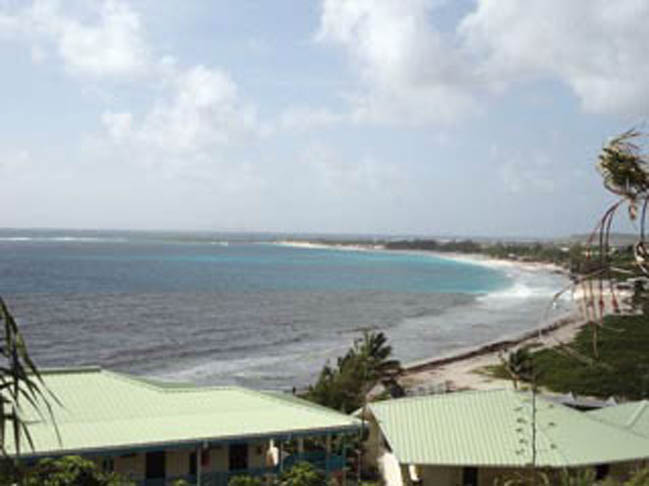
Is it necessary to remind people that fishing is completely forbidden within the Réserve Naturelle?
 Apparently it is, since there have been five times within three months when the rangers of the Réserve reported the fishermen and seized their fishing gear.
Apparently it is, since there have been five times within three months when the rangers of the Réserve reported the fishermen and seized their fishing gear.
On April 4, a ranger of the Réserve surprised a fisherman who had 40 conch shells aboard his boat.
As these mollusks were still alive, they were put back into the water.
Conch is a protected species and totally forbidden to be fished within the Réserve.
On April 6, over Easter weekend, a commercial partner of the Réserve called the rangers and alerted them that three people were aboard a boat and fishing near Caye Verte.
The ranger on duty rapidly arrived on the scene by boat and saw at least 20 fish in the fishermen’s boat, including two nurse sharks, one of which was still alive, although it had been hit with a spear.
Four spear guns were seized, along with scuba diving gear.
The wounded shark swam out to sea after 20 minutes of oxygenation in the water.
The report notes that the fishermen are guilty of an infraction worthy of a fine of 1500 euros.
On April 18, at the Galion surf spot - Baie de l’Embouchure - three rangers of the Réserve, informed by a witness, dove into the water to retrieve a fishnet over 300 meters long.
Numerous fish had already been caught in the mesh, and were freed.
The question must be asked about whether these reef fish, probably carrying the ciguatera toxin, are edible or not.
Where and by whom would they be sold ?
Who would put their health in danger by eating them ?
The net was seized and destroyed.
On September 9, 2011, at six o’clock in the morning, two fishermen in the act of placing a 300-meter fishnet were surprised by two maritime customs officials off the coast of Pinel during a joint surveillance operation led by the Réserve, the nautical gendarmes, and customs.
On April 26, 2012, the two fishermen were judged by the court in Saint Martin, and condemned to pay a fine of 5000 euros each.
Their boat, a Saintoise equipped with a 115 HP motor, was confiscated and will be sold at auction.
The net was destroyed.
On le sait, le sentier sous-marin de Pinel a obtenu la Palme initiative française pour les récifs coralliens (IFRECOR) 2011, à la grande fierté de la Réserve naturelle et du Conservatoire du littoral, à l’origine de la création de ce sentier unique dans la Caraïbe.
Le Conservatoire a décidé de créer un nouveau sentier sous-marin en Martinique, au pied du Cap Salomon, sur la commune des Anses d’Arlet.
La gestion de ce sentier sera conventionnée avec l’association SeaToyen, et plus spécialement avec Philippe Thelamon, qui gère un club de plongée non loin et sera commissionné garde du littoral en 2013.
Afin de tout savoir sur la création et la gestion d’un sentier sous-marin, Philippe Thelamon – dans le cadre des compagnonnages entre gardes mis en place par Rivages de France et financés par TE ME UM – était accueilli par la Réserve de Saint-Martin du 19 au 22 juin. Il a ainsi pu bénéficier de l’expertise et des conseils techniques du garde chef Franck Roncuzzi en cette matière et a passé deux jours en binôme sur le terrain avec Isabelle Bonnefoy, gestionnaire du sentier sous-marin de Pinel.
La passerelle de mise à l’eau à l’entrée du sentier sous-marin de Pinel, qui présentait des signes de dégradation et menaçait la sécurité des usagers, vient d’être remplacée par un équipement flambant neuf, en aluminium et en bois.
Restoration Of Degraded Areas And Populations
Officially they are well protected - they are the beneficiaries of a biotope protection order, they belong to the Littoral Conservancy, are managed by the Réserve Naturelle, and since May 1, 2012 are even listed under the Ramsar Convention - and yet the 14 ponds are still, in reality, under an enormous amount of pressure and threats: depositing of debris as well as assorted trash and refuse, untreated water from septic systems, unauthorized cutting of the mangroves...
In fact, just during the first quarter of 2012, the Salines d’Orient, the Etang aux Poissons, the Etang de Grand Case, The Etang de Chevrise and the Grand Etang des Terres Basses were all victims of recurring pollution, primarily due to malfunctions in public and private septic systems, some of which caused the death of hundreds of fish.
Reason enough for the Littoral Conservancy and the Réserve Naturelle to implement a strict, but necessary, surveillance.
Each time they see that polluting waters flow into the ponds, a well-defined procedure is put into place immediately: identification of the sources; analysis of the water if necessary to define the origin of the pollution; seeking out of those responsible, public or private; and rapidly finding a way to put a stop to the cause of the pollution.
If those at fault turn a deaf ear, the next step is a formal letter with a precise deadline to fix the problem. And if nothing is done by the time of the deadline, the matter becomes a legal issue with an official report presented by a warden of the Réserve Naturelle in the name of the police of the waters.
In 2011, eight instances of pollution were followed up on, three of which resulted in formal letters and official reports.
Since the beginning of 2012, five ponds have been polluted; six formal letters and two official reports were presented.
The 14 ponds in Saint Martin, which constitute part of the wetlands in the Réserve Naturelle, were included in the Ramsar Convention in recognition of their international ecological importance, such as, for example, the Camargue in France and The Everglades in Florida.
This international recognition confirms the importance of our island’s natural heritage, which includes the ponds and wetlands.
It also illustrates the huge responsibility of the Réserve in terms of the protection and promotion of these zones.
With this in mind, the Littoral Conservancy and the Réserve Naturelle are creating a trail to explore the mangroves in the Etang de la Barrière in Cul de Sac.
Environmental Communication And Education
L’Écho Touristique, hebdomadaire des industries du tourisme, consacre sa une et cinq pages de textes et de belles photos à Saint-Martin, dans son édition du 25 mai 2012.
La Réserve naturelle se voit accordée la large place qu’elle mérite dans cet article destiné à inciter les professionnels à vendre la destination : Tintamare, la baie du Galion, le chemin des Froussards et les étangs sont cités, comme autant de raisons de choisir Saint- Martin et de l’apprécier.
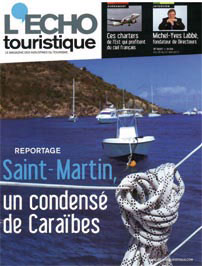
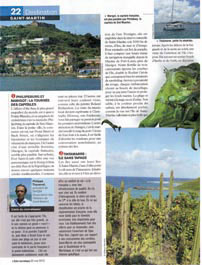
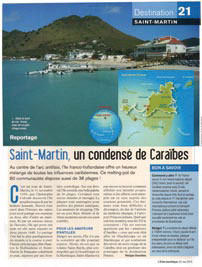
The Tuesday, June 26 opening of an exhibit of work by Marie-Estelle Voisin-Wünschendorff at the Galerie Tropismes in Grand Case was a rousing success.
Passionate about nature and environmental protection, Voisin-Wünschendorff is also a talented artist as seen in drawings she made of 50 different birds she discovered in Saint Martin.
It is possible to see the entire collection of this work in the booklet, “Saint Martin As The Bird Flies,” for sale in bookstores on the island.
Each drawing is accompanied with information about the bird and its behavior, as well as the best time to observe each one, and its reproductive season.
The Réserve Naturelle and the Littoral Conservancy are sponsors of this handsome little book and thank Paul Elliott Thuleau for hosting this exhibit.
After taken the Sentier des Froussards and hiked as far as Cactus Place, eight kids from the island on a school trip spent time picking up trash on the beach in Grandes Cayes, where they filled 22 trash bags. Donnie Arey, a professional American basketball coach, lent a big hand, along with the rangers of the Réserve. This excursion was organized on May 9 at the request of the gendarmerie’s brigade for the prevention of juvenile delinquency, as one of its ongoing activities.
.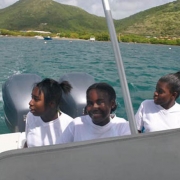
On May 30, approximately 20 junior high school students from French Quarter took their first dive with air tanks at the Remorqueur dive site, in the waters off the coast of Tintamare. Enthusiastic about this initiation to diving organized by Bubbles dive club and junior high teachers, the kids continued with a hike on Tintamare, where they discovered the flora and protected sites on this little island, in the company of rangers of the Réserve.
Almost 100 high school and junior high students participated in a nautical fair on Saturday, May 12, and sailed as far as the little island of Tintamare, in the heart of the Réserve Naturelle, with a coastline protected by the Littoral Conservancy.
Invited by Métimer, a marine professionals association, the Conservancy and the Réserve had organized a hike, which allowed small groups of students to explore the island, with its flora natural sites.
They all appreciated the pleasures of this outing at land and at sea.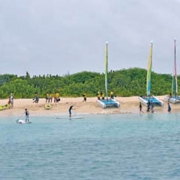
Better Means For Better Missions
Julien Chalifour, scientific director of the Réserve, and ranger Christophe Joe are now authorized to band, measure, and handle sea turtles, which are a protected species.
Both men went to Marie Galante for training offered by The National Game and Wildlife Agency (ONCFS) and run by Éric Delcroix, coordinator of the regional sea turtle network in Guadeloupe.
From June 18-21, they participated in three evening outings, between 9pm and 3am, to look for tracks of turtles in egg-laying mode.
They counted and identified the species of each turtle and whether it successfully laid its eggs or returned to the sea.
Each placed two bands on turtles and measured their shells, while procuring a small piece of flesh for DNA analysis.
These actions were taken while the turtles were depositing their eggs, at which time they are almost in a trance-like state.
The bands have a personalized identification number, which allows us to know over time, among other things, if the turtle is faithful to the same spot where it has already been observed, and to monitor its growth.
The Réserve strengthened its professional capacity when chief ranger Franck Roncuzzi obtained his national diploma for rescue-at-sea operations (BNNSA), at the end of threemonth training session, two days per week. Ranger Steeve Ruillet, who already holds this diploma (renewable every five years) took the same training course organized by the prefecture and the National Society For Rescue At Sea (SNSM), to update his knowledge. This diploma authorizes the two rangers to keep an eye on nautical activities at sea as well as zones where people swim, and have the qualifications to offer assistance to a participant on a school trip who needs help.
Two worthy recruits for the management Association of the Réserve
On May 25, 2012, the members of the management association for the Réserve Naturelle de Saint-Martin met in the territorial library in Marigot.
At this time, two high-school teachers, Eunice Augusty Thuleau and Laure Lecurieux, who wanted to become members, were voted in by the other members.
The board of directors was informed that president Alain Richardson and vice-president Ramona Connor has been designated by their peers as representatives of the Collectivité of Saint Martin on the board of the Réserve Naturelle.
Reinforcement On A Regional
Romain Renoux was invited by the Dutch Caribbean Nature Alliance (DCNA) to attend a regional coordination meeting in Saba on April 24 - 26.
Invited by the RAC-SPAW and the only representative of the French West Indies, the director of the Réserve Naturelle de Saint-Martin shared his professional experiences with the managers of protected sites in the Dutch islands, and in return profited from their knowledge.
He met with Eugene Holiday, the governor of Sint Maarten, and Tadzio Bervoets, director of the Marine Park of Sint Maarten, and congratulated them on their commitment to the protection of natural sites.
They evoked the idea of creating a protected marine zone to the southeast of Sint Maarten.
This zone, which comprises several small islets that serve as havens for marine birds, is located alongside waters already under the jurisdiction of the Réserve on the French side and could serve as important coastal protection for both sides of the island.
This project will figure on the agenda of the next meeting between Saint Martin and Sint Maarten on the subject of regional cooperation.
The DCNA, What is it?
The Dutch Caribbean Nature Alliance (DCNA) serves as an advisory technical and financial help for the six Dutch Caribbean islands - Aruba, Bonaire, Curacao, Saba, Stacia, and Sint Maarten - in terms of environmental protection.
Its mission is to preserve the biodiversity of these islands, on land and at sea, and to help those who run protected sites to have better tools to obtain better results.
Financed by the Dutch Ministry Of The Interior and a Dutch lottery - all lotteries in Holland are obliged to give part of their proceeds to NGOs - the DCNA has real means which benefits the 13 protected zones throughout the Dutch islands.
A look at their website, dcnanature.org, shows that the DCNA is on the cutting edge of environmental protection, from financing the creation of a protected zone to creation of management programs, by way of installing GPS chips on sea turtles to the creation of pedagogical kits for students.


